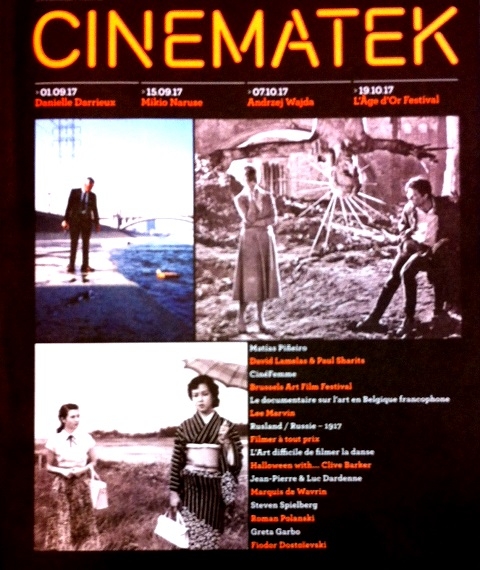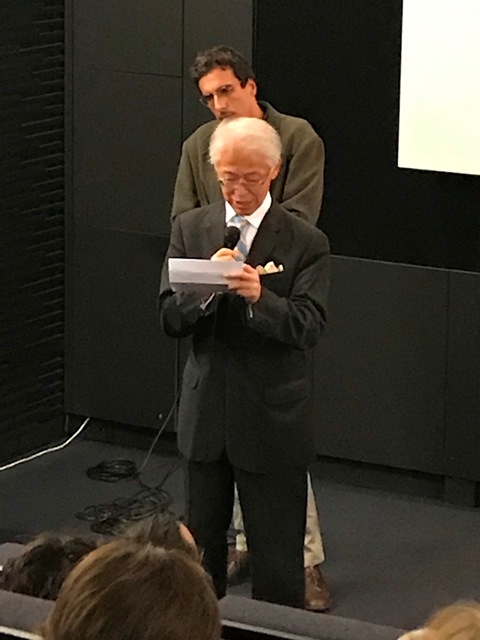Mikio Naruse @ Brussels (No. 5)
 From September 15 until October 18, an event introducing the works of film director Mikio Naruse was held at CINEMATEK, located in the center of Brussels. From September 15 until October 18, an event introducing the works of film director Mikio Naruse was held at CINEMATEK, located in the center of Brussels.
A total of 20 movies, starting from the director’s 1931 silent and the remaining oldest movie “Flunky, Work Hard”, to films in the 1930’s such as "Wife! Be Like a Rose", "Tsuruhachi & Tsurujiro" and "The Song Lantern", which raised his reputation as a film director, and numerous representative works in the 1950’s such as "Floating Clouds", all the way up to his last work in 1967, "Two in the Shadow", made two years prior to his death, were screened. Such a complete film screening focusing on one single Japanese film director is a rare opportunity for fans of foreign movies.
On this occasion, I hope that the Belgian movie fans have greatly deepened their understanding of Mr. Mikio Naruse and his works. I would like to express my sincere gratitude to all the people involved in CINEMATEK for their hard work in organizing this event and to the Japan Foundation for making this project possible.
Frankly speaking, Mr. Mikio Naruse was not necessarily a well-known movie director, except for those who are especially knowledgeable about Japanese movies. One of the reasons seems to be that there were strong rivals during that era. Kenji Mizoguchi, Yasujiro Ozu and Akira Kurosawa were all contemporaries of Mikio Naruse and they were film directors who had earned high acclaim overseas early on. Compared to these three directors, it is hard to deny that Mr. Mikio Naruse is not yet as famous.
 Another possible reason is that his works themselves are not so-called "dramatic". Mikio Naruse’s works revolve mainly around the daily lives of common people, and they do not have powerful action or violent scenes. Therefore, even though his works are well-received, it cannot be said he has received general acclaim. Another possible reason is that his works themselves are not so-called "dramatic". Mikio Naruse’s works revolve mainly around the daily lives of common people, and they do not have powerful action or violent scenes. Therefore, even though his works are well-received, it cannot be said he has received general acclaim.
So, why is Mikio Naruse introduced as one of the leading film directors of Japan overseas? To me, he is someone who made films in a very delicate way. Director Naruse meticulously shows the subtlety of the characters’ sentiment and emotion. In his work, the gradation of emotion is richly drawn. It is sometimes languid, melancholy, or gloomy. Other times it is passionate, impulsive or instinctive. Still at other times it is hateful, painful or agonizing.
In the works of director Naruse, female characters were often placed at the center of the story and it seems that his talent as a film director was poured into female characters. Because the main female role was so important, it is probably the reason why he chose actresses who were representatives for that era in each of his works. For this reason I think that Naruse’s works contained a great number of famous actresses of his days.
This time, the works of Mikio Naruse, spanning almost 40 years from the 1930's to the 1960's, were screened, and in them, the transformation of Japan itself and the life of the Japanese therein was depicted. Early works, of course, revolved around the traditional prewar Japanese agricultural society. Eventually, there were works in which the shadow of World War II could be felt, and following the era immediately after the war, when it was difficult to produce movies, works on the Japanese society in the postwar reconstruction period were created. In the end, the works of his later years entered the period of high economic growth, and became the background of the Japanese society where modernization and urbanization were advancing rapidly.
Director Mikio Naruse carefully sketches the state of change during those times, with a focus on the daily lives of the common people. In that sense, when watching his films in succession, one can feel the transition of the times. Of course, I think that the gaze of director Naruse, more than anything else, was focused on people’s feelings during those changing times. The message we get seems to be that people's feelings do not change easily, just as life itself.
Just recently, I could not help feeling happy when I found some remarks on director Naruse in the media coverage in Japan. It was when director Isao Yukisada, a contemporary Japanese director, talked about his latest work, "Narratage". Director Yukisada stated that he respects Mr. Naruse very much, and that he finds "Floating Clouds" a particularly important work, of which he is always conscious when creating movies.
The movie 'Narratage' involves popular actors and an actress in it and seems to have already a good reputation in Japan. I cannot see the movie since I live abroad, although I feel like checking for myself whether or not the influence of director Mikio Naruse and "Floating Clouds" is apparent in the movie.
|

